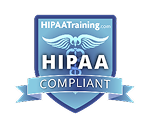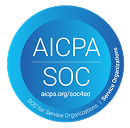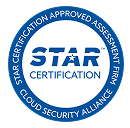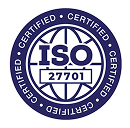Given the pace of innovation and the potential of artificial intelligence (AI), it's an exciting time for professional services. This is the moment for PS leaders to reimagine service delivery and uncover transformative opportunities for both their teams and customers. At Rocketlane, we’re committed to being catalysts of this change and doing our bit to help PS leaders actively build truly intelligent delivery organizations.
In a recent conversation, Brian Hodges, President and Co-founder of nCloud Integrators, and Srikrishnan Ganesan, CEO and co-founder of Rocketlane, explored what it means for a delivery organization to be “intelligent.” They shared inspiring examples from companies leading the way, along with actionable insights for PS leaders seeking to stay ahead of the curve.
Brian, a seasoned leader in the professional services space, has decades of experience running large-scale organizations. Before founding nCloud, he led the global professional services team at Informatica Corporation for 20 years, growing the practice to 450 consultants worldwide.
nCloud Integrators is a professional services organization that supports customers with their professional services, customer success, and data integration efforts. Over the last seven years, nCloud has collaborated with more than 600 customers, particularly those aiming to advance their digitization and optimization initiatives by leveraging AI and other cutting-edge tools.
The three unmissable traits of intelligent organizations
The future is intelligent—but what does it truly mean to be intelligent? When we think of companies like Tesla or Adobe, it’s not just their products that come to mind—it’s their ability to adapt, innovate, and lead. Here’s what sets these organizations apart:
- Nimbleness: Intelligent organizations move faster than their competitors, often leading the way in redefining industry standards and setting new benchmarks for others to follow.
- Efficiency: These companies leverage automation and AI to streamline operations, allowing them to work smarter, not harder, and achieve more with less.
- Innovation: They challenge traditional methods and are fearless in rethinking the status quo, whether it’s how cars drive, how payments are processed, or how creative tools are delivered.
A perfect example of this is Klarna. Their AI assistant now performs the work of 700 full-time agents, and the company has even built its proprietary systems, moving away from traditional platforms like Salesforce. The savings have been reinvested into the team, offering higher salaries to those leading these transformative innovations.
These bold choices have allowed Klarna to become more efficient, agile, and future-ready.
The evolution of intelligent functions: What’s holding PS back?
While AI adoption is evident in areas like customer support and marketing, professional services (PS) organizations have been slower to follow suit.
One reason could be that PS teams are constantly firefighting, focusing on delivering high-touch, complex work to customers—work that often feels irreplaceable by AI. As a result, there’s limited bandwidth to assess which aspects of this work can be streamlined or augmented through AI.
The reality, however, is that high-touch work can leverage AI—whether it’s through better resource planning, workload balancing, or predictive analytics. For example, at one of Rocketlane’s PropelX events, a presenter shared how AI helped their team tackle the challenge of migrating legacy applications to modern platforms. With AI, they were able to reduce their timeline to three months. This efficiency led the company to expand its PS team from 300 to a planned 600 employees, demonstrating how AI can create new opportunities by enabling faster, more reliable project execution.
While AI adoption in PS is still in its early stages, there are already signs of innovation. Let’s take a closer look at the many possibilities AI offers to PS functions:
1. AI as a thought partner for leaders
Leaders are increasingly turning to AI tools like Claude or OpenAI to refine ideas, draft documents, and gain fresh perspectives. These tools are used to create job descriptions, competency matrices, and more—transforming how leaders approach strategic decisions.
2. Reducing PS work with AI
The ultimate goal for PS teams is to free consultants from time-consuming, repetitive tasks so they can focus on delivering higher-value work for customers. AI is making that possible by enabling:
- Scripting and custom app development: AI-driven tools have significantly shortened the time needed to build custom apps, with development timelines shrinking from weeks to hours.
- Data analysis: AI can sift through project data to uncover inefficiencies, identify duplicated efforts, and reveal actionable insights to improve performance.
- Migrations and data transformations: AI-enabled automation is changing how PS teams handle complex data migrations, to make these processes faster, more reliable, and more cost-effective.
- Automated documentation: From creating Statements of Work (SOWs) to generating project documentation, AI can streamline time-consuming tasks so consultants can focus on delivering value to clients.
3. Driving operational efficiency
On the operations side, AI is transforming resource management, forecasting, and project execution through:
- Smart resource assignment: AI can match consultants to projects based on their skills and availability for optimal team utilization. On the flip side, it can even find opportunities for unutilized team members.
- Forecasting and profitability analysis: AI tools come with advanced forecasting abilities that help identify areas of profitability leakage.
- Automating meetings and follow-ups: AI can streamline scheduling, documentation, and follow-up communication, ensuring nothing slips through the cracks.
4. Improving professional services delivery
AI is also playing a role in improving productivity and governance within PS teams in the form of:
- Productivity improvements: Platforms like Gong and Avoma can capture meeting insights, flag risks, and identify opportunities for teams. AI helps generate accurate handoff documents, ensuring smooth transitions between teams and departments.
- Governance and early warning systems (EWS): AI can monitor budget health, scope creep, schedule delays, and customer sentiment, allowing teams to proactively address challenges and prevent escalations.
- Account intelligence: Companies can uncover patterns that traditional scorecards may miss by applying AI to customer success data. This allows for more accurate predictions of churn and better-targeted customer retention efforts. For example, nCloud worked with a client to apply AI to their success data, which helped them refine their approach to predicting churn and flagging at-risk accounts.
- Playbook compliance: Organizations often have structured processes—like how to run a kickoff or training meeting. AI can monitor adherence to these workflows, identifying deviations and ensuring consistent execution across teams. This helps maintain high standards of execution and continual process improvement.
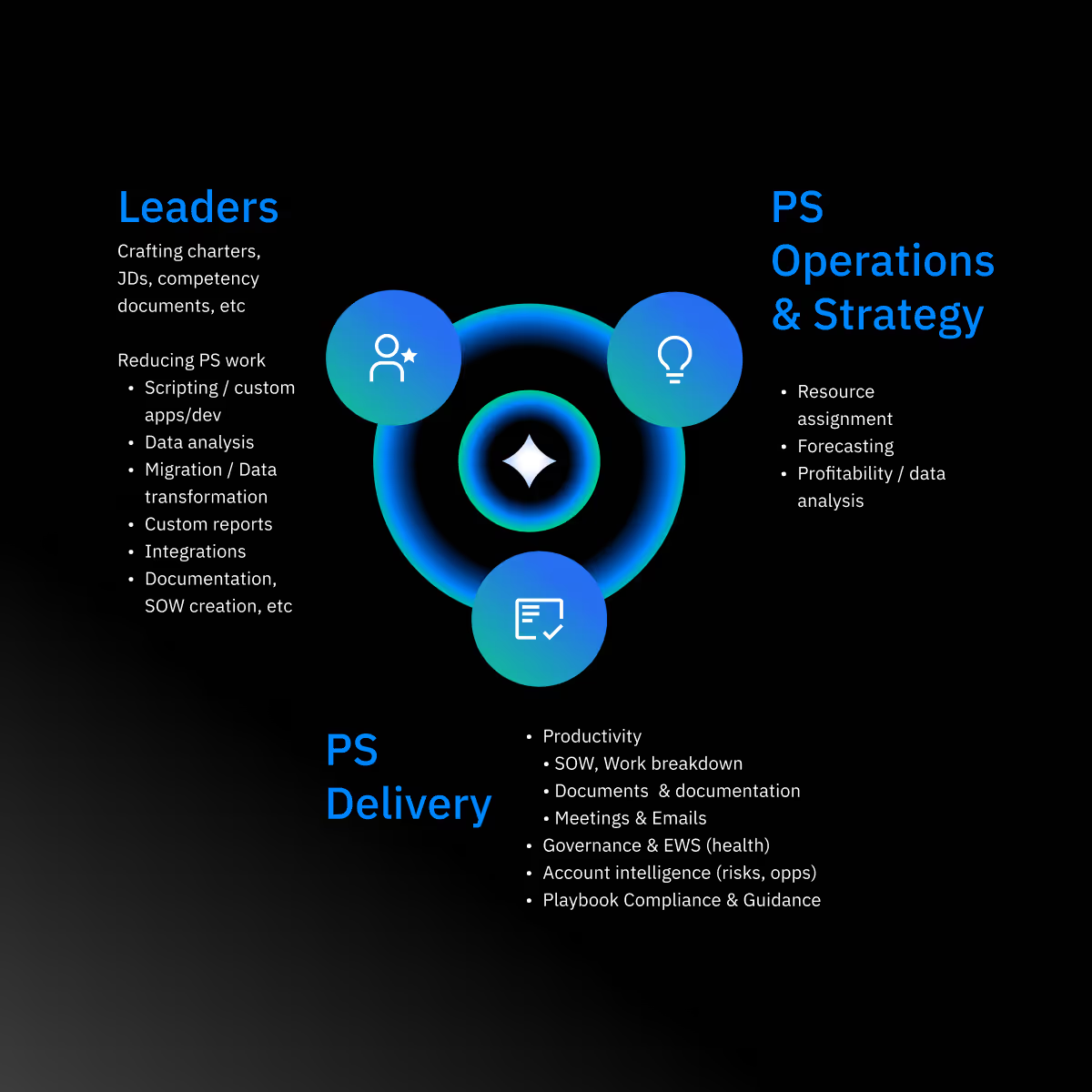
2025 and beyond: Where, how, and what impact can AI create in professional services?
Looking ahead, there's a lot of exciting potential for AI to transform how we deliver services and improve operational efficiency. Beyond the tactical changes we’re seeing today, there are some bigger opportunities on the horizon.
- Proactive monitoring and optimization: If you've developed a product, AI can help you monitor and fine-tune its performance, ensuring it’s always working at its best.
- Data-driven insights. Your customer data is a goldmine of valuable information about how clients use your product and how they compare with each other. AI can help turn that data into insights that are not only valuable to you but also to your customers, helping them improve their performance.
- AI solutions as a service: There’s also a growing trend of consultancies tapping into this space and using AI to provide more advanced solutions to their clients.
.avif)
Looking ahead, we can expect even more collaboration tools, where PS orgs and customers work together in mock environments for testing and development. AI could also play a role in offering 24/7 service and augmenting teams to handle cloud delivery with greater efficiency.
Intelligence beyond AI: What does a truly intelligent PS org look like?
An intelligent organization goes beyond just AI, integrating efficiency through automation, self-service, and data-driven insights. Here are some examples of how each of these elements plays a role in transforming professional services:
- Automation: At nCloud, consultants handle multiple engagements simultaneously, from expert services to onboarding. Traditionally, after client meetings—whether workshops, training sessions, or status updates—consultants would spend 10 to 15 minutes summarizing discussions and drafting follow-up emails. Even with templates, personalizing these summaries took valuable time. By using Rocketlane’s AI Fill, they automated this process, saving approximately 10 minutes per meeting. Over a year, this time savings is equivalent to the output of three to four full-time employees.
- Self-serve: One of Rocketlane's customers, a solutions provider for salons and spas, created a well-designed customer portal that empowers clients to take more actions independently. This self-service approach reduces the need for follow-ups from the Professional Services (PS) team, allowing them to focus on higher-value work.
- Using data: Data analysis for one of nCloud’s clients revealed that their premium onboarding offering, though priced 45% higher, only required 8% more effort compared to the standard offering. The key difference was the added focus on preparation during the initial phase, which streamlined subsequent activities. This insight allowed the organization to optimize its processes and demonstrate unexpected profitability in the premium offering.
These practices—automation, self-service, and data-driven decision-making—are essential for driving efficiency, enhancing productivity, and improving profitability in intelligent organizations.
.avif)
For 2025 and beyond, there are several considerations to enhance your business operations. Beyond the emerging capabilities of AI, PSA tools like Rocketlane already offer numerous functions that can transform your professional services. These include reusable knowledge base templates, standardized client engagement playbooks, pre-built onboarding templates, automated project management workflows, and templatized proposals and reporting.
The key is to start small and identify repetitive tasks ripe for automation—like resource allocation or data reporting—and test AI-driven tools. Equally importantly, partner wisely and work with vendors who understand the nuances of PS and are investing in AI capabilities tailored to your needs.
How being an intelligent org influences the organizational design
When thinking about the impact of AI on organizational design, there are several important factors to keep in mind. Another key consideration is workforce evolution with technology.
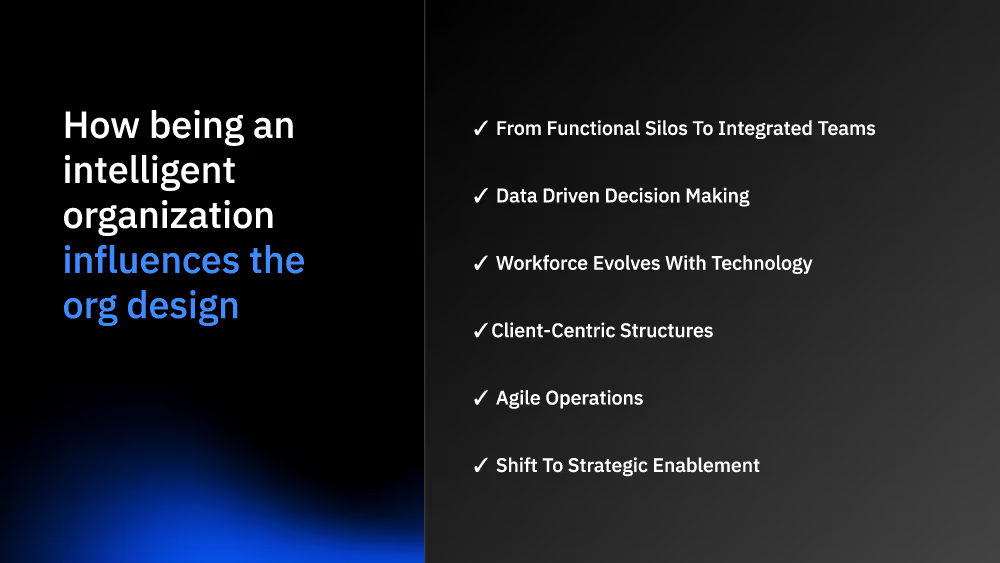
- Eliminating silos: Silos—whether within professional services teams or across different service functions—are becoming a thing of the past. AI will play a significant role in driving the reduction and elimination of these silos.
- Data-driven decision-making: The impact of data-driven decisions will shape operations teams and influence future investments.
- Workforce evolution: Companies are beginning to explore how to train their consultants for an AI-enabled world – to ensure they understand the opportunities ahead and reinforce that AI will not displace them.
- Client-centric structures: As customer expectations evolve, organizations are shifting to client-centric models that prioritize personalized experiences and long-term relationships. AI and data analytics will help make these structures foundational, enabling companies to align resources around client needs, deliver tailored solutions, and nurture customer loyalty.
- Agile operations: Organizations need to embrace agile methodologies to stay flexible and adaptive. AI will support more efficient resource management, faster decision-making, and improved project execution, so organizations can respond to customer needs quickly and effectively.
- Strategic enablement: The way work is done is changing, and organizations will need to rethink roles and responsibilities to support more dynamic organizational design.
For example, project managers may take on more responsibility for managing engagements, while consultants will need to develop new skills aligned with AI capabilities. The ratios of various team types—whether engagement managers or AI-skilled consultants—will also evolve as the landscape shifts.
Future-proofing your professional services org with AI
Looking ahead to 2025 and beyond, efficiency gains will become the new standard, and leveraging AI will be key to staying ahead of the curve and meeting future demands. As a PS leader, you need to position your organization as an AI-ready, intelligent PS org.
Here are some resources you might find helpful
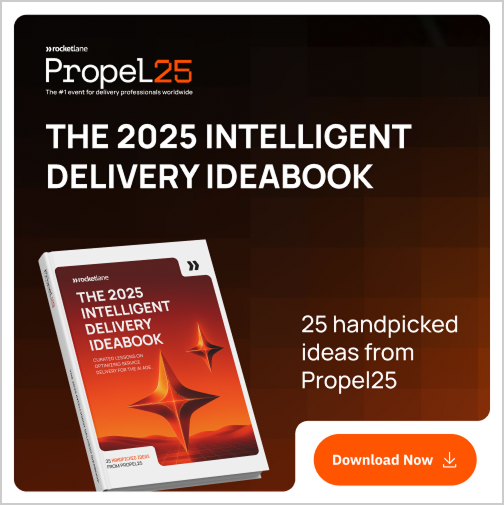


.avif)

